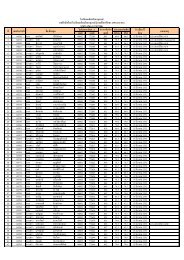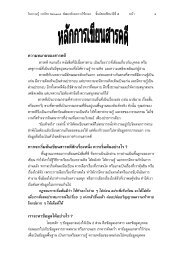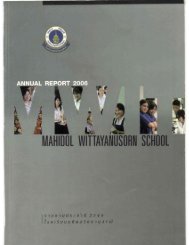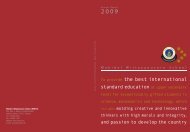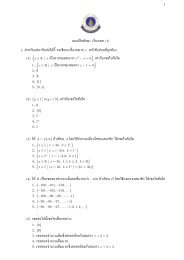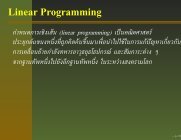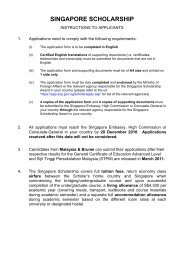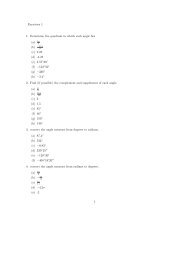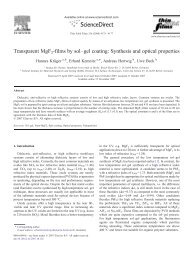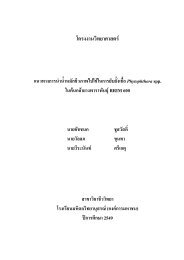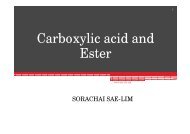Talanta Determination of chloride in admixtures and aggregates for ...
Talanta Determination of chloride in admixtures and aggregates for ...
Talanta Determination of chloride in admixtures and aggregates for ...
You also want an ePaper? Increase the reach of your titles
YUMPU automatically turns print PDFs into web optimized ePapers that Google loves.
368 J. Junsomboon, J. Jakmunee / <strong>Talanta</strong> 76 (2008) 365–368or Y = 96.5X − 16.1 (r 2 = 0.989), respectively, were obta<strong>in</strong>ed. However,these ions are usually present <strong>in</strong> the sample at relativelylow concentrations compared to Cl − <strong>and</strong> do not significantly<strong>in</strong>terfere.3.3. Application to real samplesThe system was applied to cement aggregate <strong>and</strong> <strong>admixtures</strong>amples. The samples were prepared as described <strong>in</strong> Section 2.4.The contents <strong>of</strong> Cl − <strong>in</strong> the samples were calculated us<strong>in</strong>g a calibrationgraph (Y =57.6X − 23.3, r 2 = 0.9994) <strong>and</strong> were found <strong>in</strong> range<strong>of</strong> 8–113 mg L −1 , which were converted to % (w/w) <strong>of</strong> Cl − <strong>in</strong> samplesas summarized <strong>in</strong> Table 2. The analysis <strong>of</strong> aggregate samples bytitrimetric st<strong>and</strong>ard method [2] <strong>and</strong> admixture samples by potentiometrictitration st<strong>and</strong>ard method [3] was also carried out <strong>for</strong>comparison. The st<strong>and</strong>ard methods are applied <strong>for</strong> determ<strong>in</strong>ation<strong>of</strong> total halides, except F − , reported as Cl − content. The Cl − contentsobta<strong>in</strong>ed from the proposed method were <strong>in</strong> good agreementwith those from the st<strong>and</strong>ard methods, evaluat<strong>in</strong>g by t-test at 95%confidence level [20]. It should be noted that the proposed methodhas lower detection limit (0.0002%, w/w), so it can determ<strong>in</strong>e lowerlevel<strong>of</strong>Cl − <strong>in</strong> samples with good precision. It is also faster <strong>and</strong> consumedsmaller amounts <strong>of</strong> reagents. The permission level <strong>of</strong> Cl − <strong>in</strong>concrete <strong>admixtures</strong> by Thai Industrial St<strong>and</strong>ard (TIS 733–2530) is0.20 ± 0.01%, while British St<strong>and</strong>ard is 0.10%. The application <strong>of</strong> themethod could be extended to analysis <strong>of</strong> water used <strong>in</strong> prepar<strong>in</strong>g<strong>of</strong> cement.4. ConclusionA simple Cl − ISE <strong>and</strong> FI potentiometric method have beendeveloped <strong>for</strong> the determ<strong>in</strong>ation <strong>of</strong> water soluble Cl − content <strong>in</strong><strong>aggregates</strong> <strong>and</strong> <strong>admixtures</strong> <strong>for</strong> concrete. In comparison to the st<strong>and</strong>ardmethods, the developed method provided agreeable results,moreover it is lower cost, lower reagent consumption, faster<strong>and</strong> has lower detection limit. The system gave l<strong>in</strong>ear range <strong>of</strong>10–100 mg L −1 Cl − , detection limit <strong>of</strong> 2 mg L −1 Cl − , relative st<strong>and</strong>arddeviation <strong>of</strong> 0.6–1.2% <strong>and</strong> sample throughput <strong>of</strong> 60 h −1 ,whicharecomparable to the previous flow based systems, but with simpler<strong>in</strong> <strong>in</strong>strumentation <strong>and</strong> no use <strong>of</strong> toxic or expensive chemicals.AcknowledgementsWe thank the Center <strong>for</strong> Innovation <strong>in</strong> Chemistry: PostgraduateEducation <strong>and</strong> Research Program <strong>in</strong> Chemistry (PERCH-CIC), theCommission on Higher Education (CHE) <strong>and</strong> the Thail<strong>and</strong> ResearchFund (TRF) <strong>for</strong> f<strong>in</strong>ancial support.References[1] http://en.wikipedia.org/wiki/Re<strong>in</strong><strong>for</strong>ced concrete (access on 26/1/2008).[2] British St<strong>and</strong>ard: test<strong>in</strong>g <strong>aggregates</strong>, Part 117: method <strong>for</strong> determ<strong>in</strong>ation <strong>of</strong>water soluble <strong>chloride</strong> salts (BS 812: Part 117: 1988, Method A), British St<strong>and</strong>ardInstitution, 1988.[3] British St<strong>and</strong>ard: <strong>admixtures</strong> <strong>for</strong> concrete, mortar <strong>and</strong> grout – Test Methods– Part 10: determ<strong>in</strong>ation <strong>of</strong> water soluble <strong>chloride</strong> content (BS EN 480 – 10:1997), British St<strong>and</strong>ard Institution, 1997.[4] J.F. Liu, Y.D. Feng, G.B. Jiang, J. AOAC Int. 84 (2001) 1179.[5] J.F. Liu, G.B. Jiang, <strong>Talanta</strong> 54 (2001) 329.[6] J.F. van Staden, S.I. Tlowana, Fresenius J. Anal. Chem. 371 (2001) 396.[7] C.R. Silva, H.J. Vieira, L.S. Canaes, J.A. Nobrega, O. Fatibello-Filho, <strong>Talanta</strong> 65(2005) 965.[8] F. Maya, J.M. Estela, V. Cerda, <strong>Talanta</strong> 74 (2008) 1534.[9] R.B.R. Mesquita, S.M.V. Fern<strong>and</strong>es, A. Rangel, J. Environ. Monitor. 4 (2002) 458.[10] M. Zenki, Y. Iwadou, <strong>Talanta</strong> 58 (2002) 1055.[11] V.G. Bonifacio, L.C. Figueiredo-Filho, L.H. Marcol<strong>in</strong>o, O. Fatibello-Filho, <strong>Talanta</strong>72 (2007) 663.[12] A. Andrade-Eiroa, J.A. Erustes, R. Forteza, V. Cerda, J. Lima, Anal. Chim. Acta 467(2002) 25.[13] A.M. Pimenta, A.N. Araujo, M. Conceição, B.S.M. Montenegro, C. Pasqu<strong>in</strong>i,J.J.R. Rohwedder, I.M. Raimundo-Júnior, J. Pharm. Biomed. Anal. 36 (2004)49.[14] J.E. da Silva, M.F. Pimentel, V.L. da Silva, M.D. Montenegro, A.N. Araujo, Anal.Chim. Acta 506 (2004) 197.[15] A.N. Araujo, M. Montenegro, L. Kousalova, H. Sklenarova, P. Solich, R.P. Olmos,Anal. Chim. Acta 505 (2004) 161.[16] I.S. da Silva, E.M. Richter, C.L. do Lago, I.G.R. Gutz, A.A. Tanaka, L. Angnes, <strong>Talanta</strong>67 (2005) 651.[17] J. Jakmunee, L. Patimapornlert, S. Suteerapataranon, N. Lenghor, K. Grudpan,<strong>Talanta</strong> 65 (2005) 789.[18] W. Frenzel, Fresenius J. Anal. Chem. 335 (1989) 931.[19] T. Altunbulduk, H. Meier zu Koecker, W. Frenzel, Fresenius J. Anal. Chem. 351(1995) 593.[20] G.D. Christian, Analytical Chemistry, 6th ed., Wiley, New York, USA, 2004.



